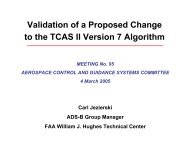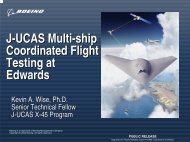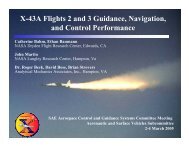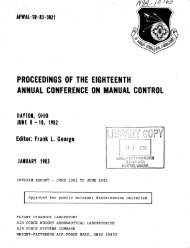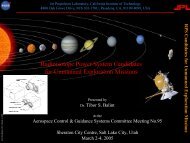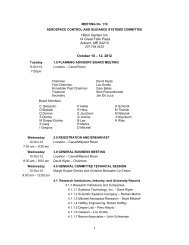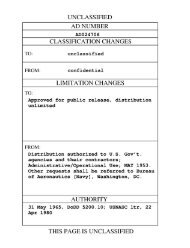Report of the Second Piloted Aircraft Flight Control System - Acgsc.org
Report of the Second Piloted Aircraft Flight Control System - Acgsc.org
Report of the Second Piloted Aircraft Flight Control System - Acgsc.org
You also want an ePaper? Increase the reach of your titles
YUMPU automatically turns print PDFs into web optimized ePapers that Google loves.
A SURVEY OF SUGGESTED MATHEMATICAL METHODS<br />
FOR THE STUDY OF HUMAN PIWT'S RESPONSES<br />
by EZRA S. KRENDEL<br />
The Franklin Institute<br />
Laboratories for Research and Development<br />
Philadelphia, Pennsylvania<br />
During <strong>the</strong> last decade considerable effort has been directed by<br />
several laboratories, both in this country and in England, toward <strong>the</strong><br />
solution <strong>of</strong> <strong>the</strong> problem <strong>of</strong> rationally characterising <strong>the</strong> human operator<br />
<strong>of</strong> various type8 <strong>of</strong> control equipment. The goal <strong>of</strong> this research has<br />
been <strong>the</strong> determination <strong>of</strong> what might be called humen "transfer functions,"<br />
where <strong>the</strong> term transfer function is used in a loose 8ense. In general,<br />
<strong>the</strong> work has dealt with problems arising in gun directing situetione.<br />
Although relatively little effort has been concetned with <strong>the</strong> study <strong>of</strong><br />
<strong>the</strong> guidance problems arising in <strong>the</strong> control <strong>of</strong> aircraft, <strong>the</strong> display and<br />
aontrol problems for sighting system and aircraft have sufficient similarity<br />
to make <strong>the</strong> suggested methods <strong>of</strong> study applicable to both problem.<br />
The purpose <strong>of</strong> this paper is to state some <strong>of</strong> <strong>the</strong> pst suggestions for<br />
appropriate ma <strong>the</strong>matical models to describe human operator performance,<br />
and to present some <strong>of</strong> <strong>the</strong> current thinking at The rh-anklin Institute on<br />
<strong>the</strong> problem.<br />
The problem under discussion arises from <strong>the</strong> control situation<br />
wherein an operator is attempting to orient a device so that a visually<br />
perceived error may be minimized. Figure one represents this situation in<br />
a simple tracking task which was Fnvestigated at The Franklin Institute.<br />
The specification <strong>of</strong> <strong>the</strong> transfer functions in this figure is only for<br />
explanatory effect. The humen element in this control system consiets <strong>of</strong><br />
<strong>the</strong> eye, which is <strong>the</strong> primary error sensing mechanism; <strong>the</strong> nerves, which<br />
are <strong>the</strong> data transmission system; and <strong>the</strong> arm muscles which are <strong>the</strong> motor<br />
system. It is, however, necessary to specify more about <strong>the</strong> situation.<br />
Since <strong>the</strong> operator is largely non-linear, <strong>the</strong> stimulus must be carefully<br />
-<br />
specified. The visual signal can be characterized by <strong>the</strong> degree to which<br />
<strong>the</strong> operator is able to predikt <strong>the</strong> stimulus. Close to perfect prediction<br />
can be achieved ei<strong>the</strong>r by having <strong>the</strong> future behavior <strong>of</strong> <strong>the</strong> signal disclosed<br />
to <strong>the</strong> operator over a length <strong>of</strong> time greater than his reaction tlme plus -<br />
movement time, or by conveying very little infomation in <strong>the</strong> visual stimulus<br />
by presenting <strong>the</strong> useful past history <strong>of</strong> a signal <strong>the</strong> future <strong>of</strong> which<br />
is determined simply from its past. ' Ekamples <strong>of</strong> <strong>the</strong> first type <strong>of</strong> easily<br />
anticipated signal arise in <strong>the</strong> driving <strong>of</strong> an automobile; whereas an exemple<br />
<strong>of</strong> <strong>the</strong> second type <strong>of</strong> predictable signal would be <strong>the</strong> tracking <strong>of</strong> a siapple<br />
sine wave. The display which a gunner sees in his sights or which a pilot<br />
sees when getting on target differs from <strong>the</strong> foregoing in <strong>the</strong>t <strong>the</strong> possible



